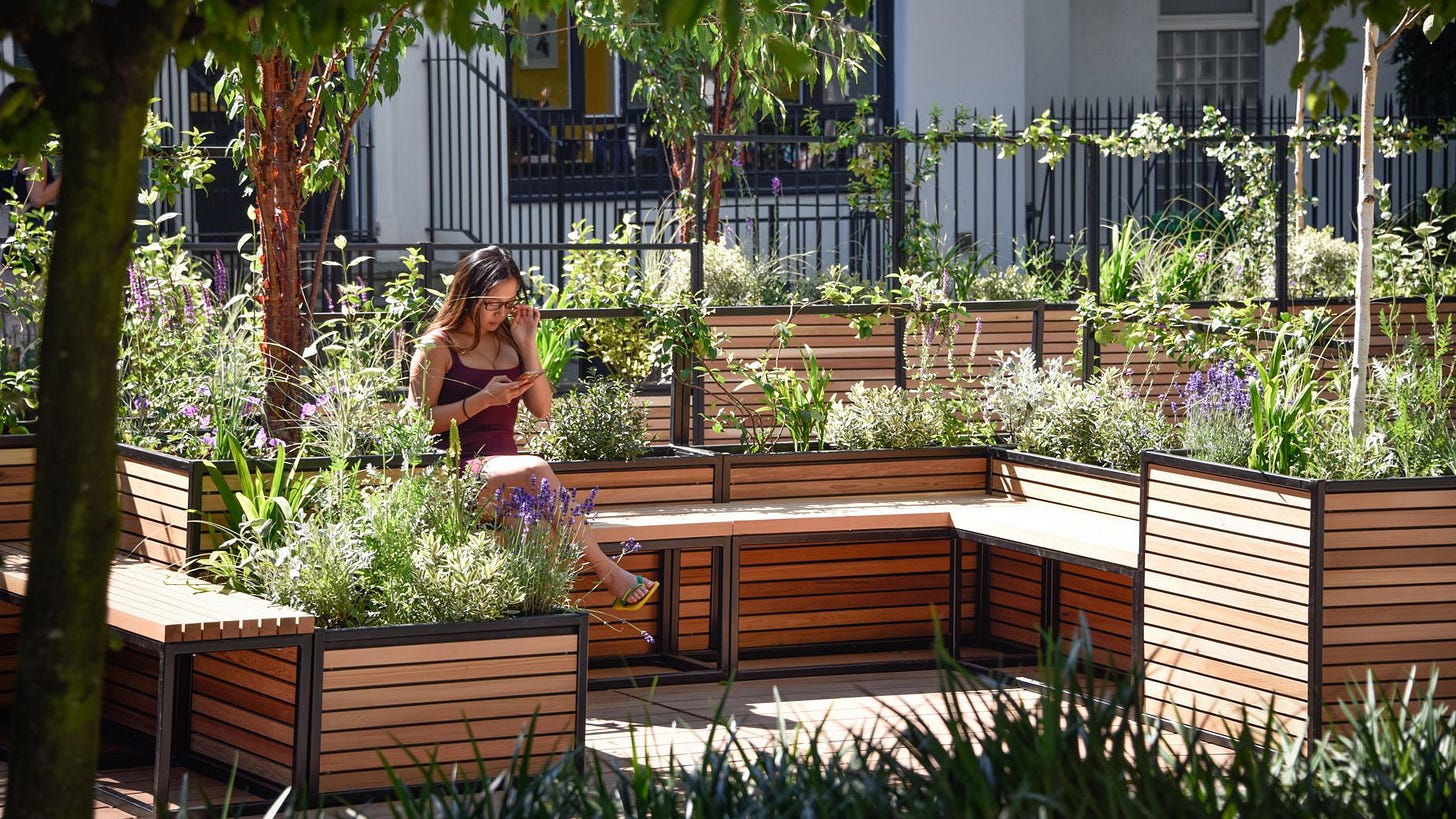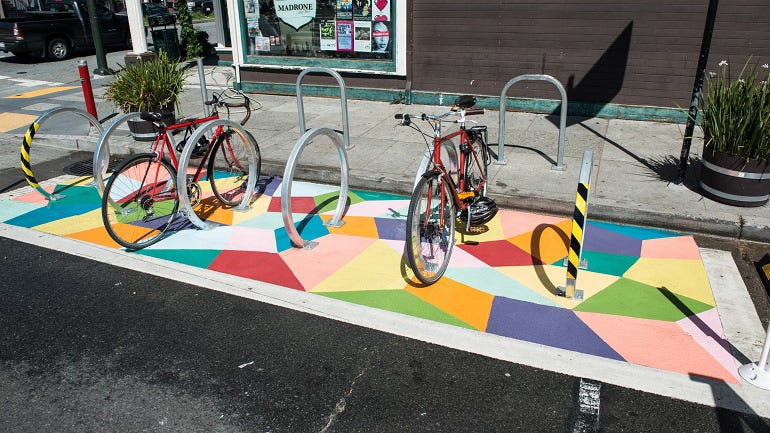Bike Corrals and Parklets Turn Parking Spots into People Spaces
Welcoming cyclists with safe parking and inviting spaces is smart economics and community building.
The morning ride was perfect, and with lunch on my mind, I knew a welcoming trail town was just a few miles ahead. Rolling into town, I spotted a diner on the trailhead map, exactly what I was looking for. Guided by bike sharrows, I followed the signs toward Main Street.
But when I arrived, the welcome wavered. Cyclists had leaned their bikes against benches and street signs, with no safe or visible racks in sight. I ended up wedging mine between a trash can and a lamppost, not exactly the picture of hospitality.
What struck me was how much this town had already invested: trail amenities, signs to downtown, storefronts proudly declaring “Cyclists welcome!” Yet the most important gesture of a safe, convenient place to park was missing. A single Main Street parking space converted into a bike corral could have made all the difference, turning the stop of necessity into a stop of choice.
The Sacred Nature of Parking Spaces
This experience isn’t unusual. Even in popular trail towns where car parking is plentiful, convenient bike parking is often overlooked.
Why? A car-first mindset persists. One parking space is seen as one customer. Limited on-street parking feels sacred, and businesses fear losing sales if a driver can’t find a spot. Rarely do they consider cyclists and pedestrians ready to spend too.
A bicycle takes up a fraction of a car space, yet streets are designed for cars. Bikes are left to fend for themselves, reinforcing a hierarchy: cars first, cyclists maybe later. Until towns rethink that, they’ll continue missing an easy opportunity to welcome a dozen cyclists, hungry and ready to shop, instead of just one parked car.
Bike Corrals Challenge the Status Quo
A bike corral replaces a single car space with secure racks for up to 12 bikes. One car space = one customer; one corral = twelve. Convenient parking encourages cyclists to stop, dine, shop, and linger, boosting foot traffic and downtown vitality.
I’ve seen this firsthand. One corral can welcome up to a dozen potential customers. They will grab coffee, enjoy a meal, visit a brewery, shop at the bike shop, or pick up a souvenir. For cyclists, secure, visible parking isn’t a luxury but an essential. Provide it, and they’ll return, supporting local businesses again and again.
The Benefits Are Real
Studies back this up. The League of American Bicyclists shows that bicyclists bring significant economic benefits, but only when infrastructure supports them.
Portland State University found strong business support for bike corrals, their role in promoting sustainable transportation, and their potential to attract more customers, despite some concerns about auto parking and maintenance.
The impact goes beyond economics. Streets with more bikes feel safer, slower, and more alive. Corrals declutter sidewalks are inexpensive to install and modular. Most importantly, they send a clear message: not everyone arrives by car, and that’s worth celebrating.
Shifting the Narrative
Towns often see giving up a car space as a loss. But one space for a single car can serve a dozen people. That perspective shift sparks conversations, small economic exchanges, and energy downtown. A bike corral isn’t just infrastructure, but a visible statement that a town values all visitors, residents, and cyclists.
As a cyclist, I know the difference between “passing through” and “stopping” often comes down to one small gesture of hospitality. Sometimes, that gesture is as simple as a safe, visible, convenient place to park my bike, a bike corral.
Here’s the Dose of Reality
Installing a bike corral takes advocacy, awareness, and community support. Cost, maintenance, and appearance are common concerns. Towns and business owners may worry about expenses, residents about clutter and appearance.
These challenges are manageable. Costs are modest compared to potential business gains, and grants or improvement funds can help. Thoughtful designs with attractive durable racks, planters, or benches can enhance the streetscape and make downtown more inviting.
Objections are understandable, but they can be reframed. A corral isn’t about taking space from drivers, but creating a downtown that serves more people, more often. One car space can now welcome many customers, which sparks more visits and personal interactions, strengthening the community.

Why Not Two Spaces?
If one parking space can be transformed into a corral, why not another into a parklet? While a corral offers convenience, a parklet offers a welcoming space with tables, benches, or greenery where people can linger, connect, and enjoy the street.
The goal isn’t just about boosting business, but about creating a calming destination. Parklets remind us that downtowns thrive when they are people-centered, not car-centered. They give someone a place to sip coffee, strike up a conversation, or catch up with a neighbor.
Converting a car space into a parklet strengthens businesses, yes, but more importantly, it strengthens the community.
Closing Thought
Welcoming cyclists isn’t about racks, corrals, or parklets. It’s the message those choices send. A town that prioritizes people over cars shows it values visitors, residents, and the small moments of connection that bring streets to life. When cyclists see that welcome, they remember and return. Turning parking spaces into people spaces isn’t a loss; it’s hospitality that pays back in stronger businesses, livelier streets, and a more connected community.




